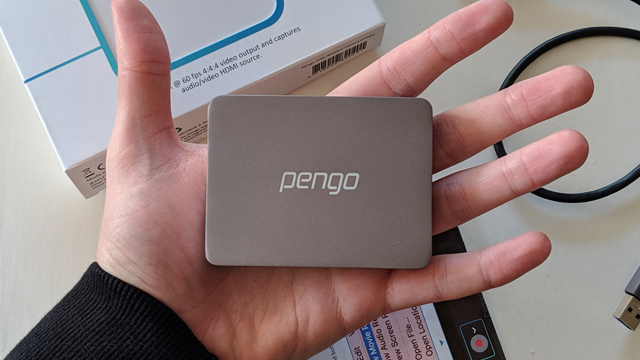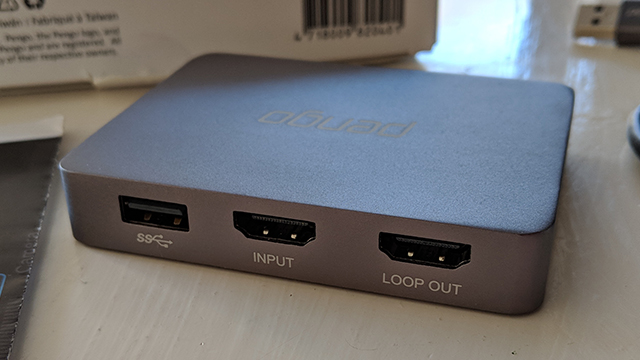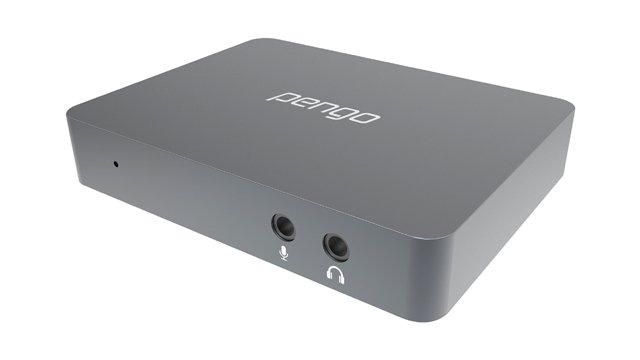This Pengo 4K HDMI Grabber review process began with me innocently searching Amazon for the latest 4K capture cards, fully expecting to see the listings dominated by Elgato and Avermedia products. While those brands did indeed pop up, so did Pengo with its “4K Grabber.” Curious about the comparatively cheap price tag, I requested a sample for review, ready to “grab” me some 4K footage, whatever that meant!
After spending a good few weeks with the device, for PS4 Pro recordings and occasionally using it in place of my usual go-to AVerMedia Live Gamer 4K for livestreams, I’ve now got a good grasp on what the Pengo 4K HDMI Grabber can and can’t do, and what exactly is meant by “Grabber.”
Pengo 4K HDMI Grabber Review – What’s in a Name?

Firstly, no, this isn’t able to capture 4K gameplay or footage. Despite its “Grabber” name, it can merely pass through that 4K signal to a television or monitor. That is the extent of its 4K capabilities. Capture itself is limited to 1080p 60 FPS, which is great, but it isn’t 4K. While it’s absolutely my fault for not diving deeper into the specs available on both Amazon and on the Pengo website, instead just assuming that “4K Grabber” was synonymous with “4K capture,” I just know there will be others who make the same assumption and end up disappointed.
Once you’ve gotten past the odd name choice and understand that this is a 4K pass-through 1080p 60 FPS capture solution, you can start to appreciate what the Pengo 4K HDMI Grabber can do, instead of what it can’t do!
Pengo 4K HDMI Grabber Review – Simple and Stealthy

The Pengo 4K HDMI Grabber is a surprisingly compact and well-built piece of kit. While its cheap and simple packaging won’t blow you away, the device itself has a solid metal case, which feels plenty capable of withstanding portable use. A big rubber foot helps prevent the Pengo 4K from slipping around on a desk, which is a nice touch. There are two available colors: Titanium Gray and Silver. Both come with the Pengo logo emblazoned atop in a large white font. The rest of the product looks very clean, with HDMI In and Out, the USB 3.0 data transfer and power combo, and the mic in and headphone out, all clearly labeled. It’s a very tidy and non-gamer aesthetic, which I’m sure many will appreciate.
Included in the box alongside the Pengo 4K is a manual on how to get it working, as well as a curious USB 3.0 Type A Male to Type A Male cable which, while unusual, still works fine and doesn’t feel overly cheap or likely to break anytime soon. There is no HDMI cable included in the box, which is disappointing, as not everyone has multiple HDMI 2.0 cables lying around for 4K pass-through.
The mic in and headphone out are fantastic to see, allowing the user to hear gameplay and add voice or music via the two 3.5 mm ports. This is a very convenient option to have and it really adds to the whole potential portability factor.
So the hardware is solid enough, but what about the software? Well, the Pengo 4K HDMI Grabber doesn’t actually come with its own software. You might be used to hearing about Elgato and Avermedia with their own recommended applications that allow for some unique functionality, but the Pengo 4K has nothing. The manual instead recommends users download PotPlayer on Windows, and VLC or Quicktime on Mac. I opted for OBS Studio, as it’s my daily driver for 99% of all streaming and gameplay capture I do. As a UVC plug-in-and-play device, the Pengo 4K was immediately recognized and just worked perfectly from the get-go. I recorded Black Ops 4 gameplay at 1080p 60 FPS with a bitrate of 50 Mbps. You can push that bitrate further, but for 1080p 60 FPS on YouTube, 50 Mbps is already overkill. As you would expect, the unit handled Twitch streaming perfectly fine, easily handling my 2.5 Mbps bitrate (x264 Medium preset).
Using my PS4 Pro to output 4K gameplay through the Pengo 4K HDMI Grabber to my 4K HDR monitor, I was as to capture the flawless—before YouTube’s horrible compression—1080p 60 FPS gameplay which you see above. While I was certainly able to take advantage of the 4K pass-through to carry on enjoying the latest Call of Duty release running at 4K with no latency, HDR was automatically disabled. To be expected, perhaps, but still worth noting.
The plug-in-and-play feature also adds to the portability, speeding up the process when capturing on the go. While internal capture cards that are plugged into the motherboard can leverage more bandwidth for incredible transfer speeds and 4K HDR capture, they still remain stuck inside the PC. If you’re a gamer who plays in multiple spaces, or want the flexibility of recording to a laptop, then external is the way to go, and Pengo is offering a good option here. The system requirements detailed on the official website aren’t very demanding, with an i3 dual core or higher CPU, 2 GB of RAM, and modern OS listed as recommended.
Pengo 4K HDMI Grabber Review – Pick Up a Pengo

At $150, the Pengo 4K HDMI Grabber is priced competitively, currently sitting at $30 cheaper than the $180 Avermedia Live Gamer EXTREME 2, which rocks a much more gamer aesthetic. You also shouldn’t forget about the addition of a headphone out and mic in, which really help the Pengo 4K stand out. While Avermedia might seem like the safer bet, due to being a well-known brand and its use of USB 3.1 over 3.0, I still think the Pengo is well worth considering. The cheaper price, and fact that it can be bought through Amazon, gives me confidence with regards to potential returns and good customer service. Buying from Amazon makes taking a risk on a relatively unknown brand like Pengo a lot less worrying.
As a 4K pass-through 1080p 60 FPS capture solution, the Pengo 4K HDMI Grabber works great. So long as you’re a creator who is familiar with OBS or other capture software, you should have no problems using this product as a compact capture and streaming device, without sacrificing your own enjoyment of 4K content on your own screen. Good stuff, Pengo!
Pengo 4K HDMI Grabber review unit was provided by Pengo.







